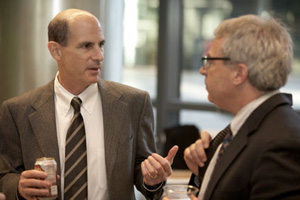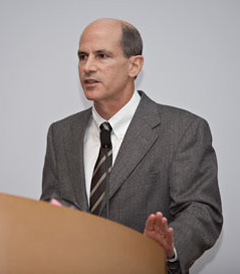Inaugural event for new research center probes how to slow the aging process.
Inaugural event for new research center probes how to slow the aging process
Once seen as a ticket to obscurity, the field of aging research is coming of age. This can be seen in the convergence of thinking demonstrated at the Jan. 31 Frontiers in Aging symposium at the Clark Center auditorium.

Stanford’s Thomas Rando (left) talks with Nir Barzilai of the Albert Einstein College of Medicine at a Jan. 31 symposium on aging./ Steve Gladfelter/VAS
Virtually every symposium speaker voiced a common theme: Rather than focus narrowly on one or another of numerous aging-related diseases — from cancer to arthritis to Alzheimer’s — the best way to delay or prevent all those diseases is to slow the aging process.
“The biggest single risk factor for the diseases of aging is aging itself,” Nir Barzilai, MD, professor of medicine and molecular genetics and director of the Institute for Aging Research at the Albert Einstein College of Medicine in Manhattan, told the standing-room-only crowd. Barzilai’s group is studying some 540 Ashkenazi Jews, ages 95-112. These exceptionally long-lived people smoke, drink and overeat as much as anyone, he said.
Certain gene variants are significantly more common among them, and others are significantly rarer, than among other Ashkenazis. It’s not so much that the evergreen oldsters have “perfect genomes” devoid of deleterious gene variants, Barzilai said. Rather, their genomes appear to harbor variants that protect them from the damage their deleterious DNA variants and personal predilections would otherwise wreak. Zooming in on the genomes of the roughly one in 5,000 people who live to the age of 100 — and further narrowing the study population to a single ethnic group — is an efficient way of identifying versions of genes that distinguish long-lived from shorter-lived but otherwise similar people, he said.
..
The symposium was the inaugural event of the newly established Paul F. Glenn Laboratories for the Biology of Aging at Stanford. It kicks off a series of Monday-afternoon seminars on the underlying biology of aging that will bring in researchers from institutions around the globe.
Last February, the Glenn Foundation for Medical Research, whose goal is to extend people’s healthy, productive years through such research, awarded $5 million to Stanford to get the Glenn Laboratories up and running.
Sinking money and energy into understanding the biology of aging is simply common sense. There are now about 65 million baby boomers in the United States; every day, about 10,000 of them turn 65. As this tsunami builds, public funding of research on the biology of aging is increasing, but remains relatively puny. The National Institute on Aging awards about $175 million annually for aging research.
Private foundations have picked up the slack to a great extent, said Glenn Foundation president Mark Collins at the symposium. The Ellison Medical Foundation supports about $40 million worth of aging-related research per year, while the Glenn Foundation contributes $10 million annually, Collins said.
With the addition of the Glenn lab at Stanford, there are now four Glenn Foundation-funded clusters for research on aging. The others are located at Harvard, MIT and the Salk Institute for Biological Studies in La Jolla, Calif.
..

Rando is the director of the Glenn Laboratories for the Biology of Aging at Stanford../ Steve Gladfelter/VAS
The Stanford center is directed by Thomas Rando, MD, PhD, professor of neurology and neurological sciences. Its associate directors are Anne Brunet, PhD, associate professor of genetics, and Steven Artandi, MD, PhD, associate professor of medicine. This group has a distinct focus, studying how changes that occur in stem cells in various tissues as we grow older contribute to the development of age-related disorders.
While the study of aging at the molecular and cellular level is still new enough to be considered revolutionary, experimentation aimed at extending life is at least as old as our species’ recorded history. One method that has worked in every species in which it’s been tried is dietary restriction, said another symposium speaker, Dame Linda Partridge, PhD, professor of genetics at University College London and founding director at the Max Planck Institute for Biology of Ageing in Cologne, Germany. From tiny nematode worms to monkeys, cutting caloric intake by half seems to substantially increase healthy life spans. Human trials along these lines would be ethically thorny (you can’t keep humans caged up to prevent them from following their noses into a fast-food joint) and — given our lengthy life span — immensely costly, but Partridge said a number of experimentation-minded people are restricting their dietary intake voluntarily.
“I run into such people at meetings,” she said. “They don’t look very happy.”
Partridge and the other symposium speakers agreed that pharmaceutical interventions allowing us to eat hearty but still reap dietary restriction’s longevity-extending effects would be an easier pill to swallow. Experiments by her group suggest it may not be calories per se, but possibly specific nutrients or combinations of them in specific proportions that account for dietary restriction’s salutary effects on health and life span.
Andrew Dillin, PhD, director of the Salk Institute’s Glenn Center for Aging Research, reported on his team’s findings of activities within cells of certain tissues that influence rates of aging not only in those cells or tissues but also in bodily regions quite far away from them. Drugs that could stimulate the secretion of whatever chemical signals these cells are releasing might hold promise, he said.
The symposium was followed afterward with a sumptuous “dietary non-restriction” reception in Clark’s cafeteria.
###
* Stanford University Medical Center integrates research, medical education and patient care at its three institutions – Stanford University School of Medicine, Stanford Hospital & Clinics and Lucile Packard Children’s Hospital.
** The above story is adapted from materials provided by Stanford University School of Medicine
________________________________________________________________




















